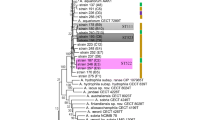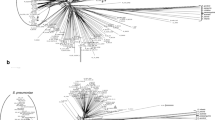Abstract
The authors reported the isolation and genetic characterization of Sporothrix schenckii strains from natural environmental samples and commercial amended and garden soils. Twenty-six isolates were recovered and identified as S. schenckii by using both phenotypic and molecular methods. The majority of the strains were isolated from commercial amended and garden soils, indicating that these products represent an important reservoir of the fungus. Sequencing and phylogenetic analysis of the D1-D2 region of the 28S rRNA gene of environmental isolates, including S. schenckii ATCC 10268 and two Italian clinical strains, revealed a degree of difference sufficient to justify the separation of the examined isolates in two principal groups (environmental and clinical). Such separation in two groups is further supported by two well-conserved nucleotide polymorphisms, caused by single-base transitions, in the D1-D2 domain of rDNA. In this study, the presence in nature and/or in commercial products of S. schenckii is discussed. To our knowledge, this is the first study that reports the environmental isolation of S. schenckii from southern Italy.





Similar content being viewed by others
References
Schubach TM, de Oliveira Schubach A, dos Reis RS, Cuzzi-Maya T, Blanco TC, Monteiro DF, et al. Sporothrix schenckii isolated from domestic cats with and without sporotrichosis in Rio de Janeiro, Brazil. Mycopathologia. 2002;153:83–6.
Lopes-Bezerra LM, Schubach A, Costa RO. Sporothrix schenckii and sporotrichosis. An Acad Bras Cienc. 2006;78:293–308.
Cafarchia C, Sasanelli M, Lia RP, de Caprariis D, Guillot J, Otranto D. Lymphocutaneous and nasal sporotrichosis in a dog from southern Italy: case report. Mycopathologia. 2007;163:75–9.
Ramos-e-Silva M, Vasconcelos C, Carneiro S, Cestari T. Sporotrichosis. Clin Dermatol. 2007;25:181–7.
Kauffman CA. Sporotrichosis. Clin Infec Dis. 1999;29:231–6.
Bustamante B, Campos PE. Endemic sporotrichosis. Curr Opin Infect Dis. 2001;14:145–9.
Morris-Jones R. Sporotrichosis. Clin Exp Dermatol. 2002;27:427–31.
Schubach A, Barros MB, Wanke B. Epidemic sporotrichosis. Curr Opin Infect Dis. 2008;21:129–33.
Klein BS, Tebbets B. Dimorphism and virulence in fungi. Curr Opin Microbiol. 2007;10:314–9.
Berbee ML, Taylor JW. 18S ribosomal RNA gene sequence characters place the human pathogen Sporothrix schenckii in the genus Ophiostoma. Exp Mycol. 1992;16:87–91.
de Meyer EM, de Beer ZW, Summerbell RC, Moharram AM, de Hoog GS, Vismer HF, et al. Taxonomy and phylogeny of new wood- and soil-inhabiting Sporothrix species in the Ophiostoma stenoceras-Sporothrix schenckii complex. Mycologia. 2008;100:647–61.
Mesa-Arango AC, Del Rocío Reyes-Montes M, Pérez-Mejía A, Navarro-Barranco H, Souza V, Zúñiga G, et al. Phenotyping and genotyping of Sporothrix schenckii isolates according to geographic origin and clinical form of Sporotrichosis. J Clin Microbiol. 2002;40:3004–11.
Mehta KI, Sharma NL, Kanga AK, Mahajan VK, Ranjan N. Isolation of Sporothrix schenckii from the environmental sources of cutaneous sporotrichosis patients in Himachal Pradesh, India: results of a pilot study. Mycoses. 2007;50:496–501.
Ishizaki H, Kawasaki M, Anzawa K, Mochizuki T, Chakrabarti A, Ungpakorn R, et al. Mitochondrial DNA analysis of Sporothrix schenckii in India, Thailand, Brazil, Colombia, Guatemala and Mexico. Nippon Ishinkin Gakkai Zasshi. 2009;50:19–26.
Travassos LR, Lloyd KO. Sporothrix schenckii and related species of Ceratocystis. Microbiolo Rev. 1980;44:683–721.
Criseo G, Malara G, Romeo O, Puglisi Guerra A. Lymphocutaneous sporotrichosis in an immunocompetent patient: a case report from extreme southern Italy. Mycopathologia. 2008;166:159–62.
Cryer DR, Eccleshall R, Marmur J. Isolation of yeast DNA. Methods Cell Biol. 1975;12:39–44.
Sambrook J, Fritsch EF, Maniatis T. Molecular cloning: a laboratory manual. 2nd ed. New York: Cold Spring Harbor Laboratory Press; 1989.
Kanbe T, Natsume L, Goto I, Kawasaki M, Mochizuki T, Ishizaki H, et al. Rapid and specific identification of Sporothrix schenckii by PCR targeting the DNA topoisomerase II gene. J Dermatol Sci. 2005;38:99–106.
O’Donnell K. Fusarium and its near relatives. In: Reynolds R, Taylor JW, editors. The fungal holomorph: mitotic, meiotic and pleomorphic speciation in fungal systematics. United Kingdom: CAB International; 1993. p. 225–33.
Tamura K, Dudley J, Nei M, Kumar S. MEGA4: Molecular Evolutionary Genetics Analysis (MEGA) software version 4.0. Mol Biol Evol. 2007;24:1596–9.
Altschul SF, Madden TL, Schäffer AA, Zhang J, Zhang Z, Miller W, et al. Gapped BLAST and PSI-BLAST: a new generation of protein database search programs. Nucleic Acids Res. 1997;25:3389–402.
Suh SO, Kurtzman CP, Blackwell M. The status of Endomyces scopularum–a filamentous fungus and two yeasts. Mycologia. 2001;93:317–22.
de Beer ZW, Harrington TC, Vismer HF, Wingfield BD, Wingfield MJ. Phylogeny of the Ophiostoma stenoceras-Sporothrix schenckii complex. Mycologia. 2003;95:434–41.
Barile F, Mastrolonardo M, Loconsole F, Cantuccio F. Cutaneous sporotrichosis in the period 1978–1992 in the province of Bari, Apulia, Southern Italy. Mycoses. 1993;36:181–5.
Baroni A, Palla M, Novene MR, Faccenda F, Aiello FS, Puca RV, et al. Sporotrichosis: success of itraconazole treatment. Skin Med. 2007;6:41–4.
Dixon DM, Salkin IF, Duncan RA, Hurd NJ, Haines JH, Kemna ME, et al. Isolation and characterization of Sporothrix schenckii from clinical and environmental sources associated with the largest US epidemic of sporotrichosis. J Clin Microbiol. 1991;29:1106–13.
Hajjeh R, McDonnell S, Reef S, Licitra C, Hankins M, Toth B, et al. Outbreak of sporotrichosis among tree nursery workers. J Infect Dis. 1997;176:499–504.
Almeida-Paes R, Pimenta MA, Pizzini CV, Monteiro PC, Peralta JM, Nosanchuk JD, et al. Use of mycelial-phase Sporothrix schenckii exoantigens in an enzyme-linked immunosorbent assay for diagnosis of sporotrichosis by antibody detection. Clin Vaccine Immunol. 2007;14:244–9.
Zhang X, Andrews JH. Evidence for growth of Sporothrix schenckii on dead but not on living Sphagnum moss. Mycopathologia. 1993;123:87–94.
Powell KE, Taylor A, Phillips BJ, Blakey DL, Campbell GD, Kaufman L, et al. Cutaneous sporotrichosis in forestry workers. Epidemic due to contaminated Sphagnum moss. JAMA. 1978;240:232–5.
Grotte M, Younger B. Sporotrichosis associated with Sphagnum moss exposure. Arch Pathol Lab Med. 1981;105:50–1.
Coles FB, Schuchat A, Hibbs JR, Kondracki SF, Salkin IF, Dixon DM, et al. A multistate outbreak of sporotrichosis associated with Sphagnum moss. Am J Epidemiol. 1992;136:475–87.
Marimon R, Gené J, Cano J, Trilles L, Dos Santos Lazéra M, Guarro J. Molecular phylogeny of Sporothrix schenckii. J Clin Microbiol. 2006;44:3251–6.
Acknowledgments
We are very grateful to Professor Claudia Cafarchia, University of Bari-Italy, for providing us the clinical strain: S. schenckii CDM18. We also thank Professor Rosella Picone, University of Messina, for collecting the Sphagnum moss specimens and Dr Roberta Malavenda and Ronan Gilligan for their assistance during the drafting of the manuscript.
Author information
Authors and Affiliations
Corresponding author
Rights and permissions
About this article
Cite this article
Criseo, G., Romeo, O. Ribosomal DNA Sequencing and Phylogenetic Analysis of Environmental Sporothrix schenckii Strains: Comparison with Clinical Isolates. Mycopathologia 169, 351–358 (2010). https://doi.org/10.1007/s11046-010-9274-9
Received:
Accepted:
Published:
Issue Date:
DOI: https://doi.org/10.1007/s11046-010-9274-9




